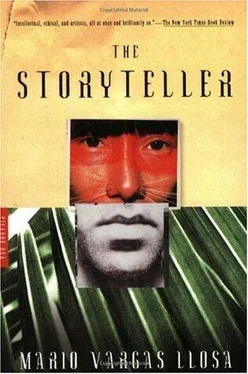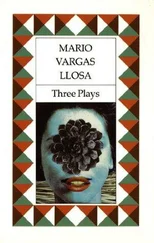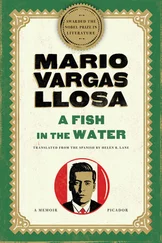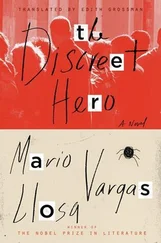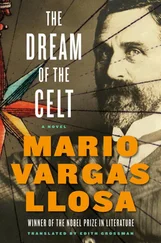Mario Vargas Llosa - The Storyteller
Здесь есть возможность читать онлайн «Mario Vargas Llosa - The Storyteller» весь текст электронной книги совершенно бесплатно (целиком полную версию без сокращений). В некоторых случаях можно слушать аудио, скачать через торрент в формате fb2 и присутствует краткое содержание. Год выпуска: 2001, Издательство: Picador, Жанр: Современная проза, на английском языке. Описание произведения, (предисловие) а так же отзывы посетителей доступны на портале библиотеки ЛибКат.
- Название:The Storyteller
- Автор:
- Издательство:Picador
- Жанр:
- Год:2001
- ISBN:нет данных
- Рейтинг книги:3 / 5. Голосов: 3
-
Избранное:Добавить в избранное
- Отзывы:
-
Ваша оценка:
- 60
- 1
- 2
- 3
- 4
- 5
The Storyteller: краткое содержание, описание и аннотация
Предлагаем к чтению аннотацию, описание, краткое содержание или предисловие (зависит от того, что написал сам автор книги «The Storyteller»). Если вы не нашли необходимую информацию о книге — напишите в комментариях, мы постараемся отыскать её.
The Storyteller — читать онлайн бесплатно полную книгу (весь текст) целиком
Ниже представлен текст книги, разбитый по страницам. Система сохранения места последней прочитанной страницы, позволяет с удобством читать онлайн бесплатно книгу «The Storyteller», без необходимости каждый раз заново искать на чём Вы остановились. Поставьте закладку, и сможете в любой момент перейти на страницу, на которой закончили чтение.
Интервал:
Закладка:
We were stretched out on a floor of beaten earth, sharing a mosquito net, in a hut reeking of rubber (it was the storeroom of Urakusa), surrounded by the breathing of our slumbering companions and the unfamiliar sounds of the jungle. At the time, Matos Mar and I also shared socialist ideas and enthusiasms, and in the course of our talk together, the familiar subject of the social relations of production, which like a magic wand served to explain and resolve all problems, naturally cropped up. The problem of the Urakusas, that of all the tribes, should be seen as part of the general problem resulting from the class structure of Peruvian society. By substituting for the obsession with profit — individual gain — the idea of service to the community as the incentive to work, and reintroducing an attitude of solidarity and humanity into social relations, socialism would make possible that coexistence between modern and primitive Peru that Mascarita thought impossible and undesirable. In the new Peru, infused with the science of Marx and Mariategui, the Amazonian tribes would, at one and the same time, be able to adopt modern ways and to preserve their essential traditions and customs within the mosaic of cultures that would go to make up the future civilization of Peru. Did we really believe that socialism would ensure the integrity of our magico-religious cultures? Wasn’t there already sufficient evidence that industrial development, whether capitalist or communist, inevitably meant the annihilation of those cultures? Was there one exception anywhere in the world to this terrible, inexorable law? Thinking it over — in the light of the years that have since gone by, and from the vantage point of this broiling — hot Firenze — we were as unrealistic and romantic as Mascarita with his archaic, anti — historical utopia.
That long conversation with Matos Mar under the mosquito net, watching the dark pouches hanging from the palm-leaf roof sway back and forth — by daybreak they had mysteriously disappeared, and turned out to be balls of hundreds of spiders that curled up together in the huts at night, by the warmth of the fire — is one of the undying memories of that journey. Another: a prisoner of an enemy tribe whom the Shapras of Lake Morona allowed to wander peacefully around the village. His dog, however, was shut up in a cage and was watched very closely. Captors and captive were evidently in agreement as to the symbolic import of this; in the minds of both parries the caged animal kept the prisoner from running away and bound him to his captors more securely — the force of ritual, of belief, of magic — than any iron chain could have. And yet another: the gossip and fantastic tales we heard all during the journey concerning a Japanese adventurer, rogue, and feudal lord called Tushía, who was said to live on an island in the Pastaza River with a harem of girls he’d abducted from all over Amazonia.
But, in the long run, the most haunting memory of that trip — one that on this Florentine afternoon is almost as searing as the summer sun of Tuscany — is doubtless the story I heard a couple of linguists, Mr. and Mrs. Schneil, tell in Yarinacocha. At first I had the impression that I had never heard the name of that tribe before. But suddenly I realized that it was the same one that Saúl had told me so many stories about, the one he had come in contact with on his first trip to Quillabamba: the Machiguengas. Yet, except for the name, the two didn’t seem to have much in common.
Little by little I began to understand the reason for the discrepancy. Though it was the same tribe — numbering between four and five thousand — the Machiguengas were a people split apart. This explained the differences between the two groups and their different relationships with the rest of Peru. A dividing line, whose chief topographical feature was the Pongo de Mainique, separated the Machiguengas scattered about in the ceja de montaña — a wooded region below the high sierra where whites and mestizos were numerous — from the Machiguengas of the eastern region, on the far side of the Pongo, where the Amazonian plain begins. A geographical accident, the narrow gorge between mountains where the Urubamba becomes a raging torrent, filled with foam, whirlpools, and deafening tumult, separated the Machiguengas above, who were in contact with the white and mestizo world and had begun the process of acculturation, from the others, scattered through the forests of the plain, living in near-total isolation and preserving their traditional way of life more or less unchanged. The Dominicans had established missions — such as Chirumbia, Koribeni, and Panticollo — among the former, and in that region there were also Viracocha farms, where a few Machiguengas worked as hired hands. This was the domain of the famous Fidel Pereira and the Machiguenga world described in Saúl’s stories: the one most Westernized and most exposed to the outside.
The other part of the community (but, under such conditions, could one speak of a community?), scattered over the enormous area of the Urubamba and Madre de Dios basins, kept itself jealously isolated, even at the end of the fifties, and resisted any form of contact with the whites. The Dominican missionaries had not reached them, and, for the moment at least, there was nothing in that region to attract the Viracochas. But even this sector was not homogeneous. Among these primitive Machiguengas there was an even more archaic small group or fraction, hostile to the others, known by the name of Kogapakori. Centered on the region bathed by two tributaries of the Urubamba, the Timpía and the Tikompinía, the Kogapakori went about stark-naked, though some of the men wore phallic sheaths made of bamboo, and attacked anyone who entered their territory, even those who were ethnically related. Their case was exceptional, for, compared with other tribes, the Machiguengas were traditionally peaceful. Their gentle and docile nature had made them choice victims of the rubber boom, during the great manhunts to provide Indian labor for the rubber camps, at which time the tribe had been literally decimated and on the point of disappearing. For the same reason they had always come off the losers in skirmishes with their age-old enemies the Yaminahuas and the Mashcos, especially the latter, famous for their bellicosity. These were the Machiguengas the Schneils told us about. For two years and a half they had been working to make themselves accepted by the groups with which they had succeeded in making contact, yet they still encountered distrust and even hostility on their part.
Yarinacocha at dusk, when the red mouth of the sun begins to sink behind the treetops and the greenish lake glows beneath the indigo sky where the first stars are beginning to twinkle, is one of the most beautiful sights I have ever seen. We were sitting on the porch of a wooden house contemplating, over the Schneils’ shoulders, the horizon line of the darkening forest. It was a magnificent sight. But I think we all felt uncomfortable and depressed. For the story they told us — they were young, with that healthy, candid, puritanical, hardworking air about them that all the linguists wore like a uniform — was a dismal one. Even the two anthropologists of the group, Matos Mar and the Mexican, Juan Comas, were surprised at the depths of prostration and pessimism to which, according to the Schneils, the broken-spirited Machiguenga people had been reduced. From what we heard, the tribe seemed to be virtually falling apart.
These Machiguengas had hardly been studied. Except for a slim volume published in 1943 by a Dominican, Father Vicente de Cenitagoya, and a few articles by other missionaries on their customs and their language, which had appeared in the journals of the Order, no serious ethnographic study of them existed. They belonged to the Arawak family and there was some confusion between them and the Campas of the Ene, Perené, and Gran Pajonal Rivers, since their languages had common roots. Their origin was a total mystery; their identity, blurred. Vaguely referred to as Antis by the Incas, who expelled them from the eastern part of the Cusco region but were never able to invade their jungle territory or subjugate them, they appear in the Chronicles and Relations of the Colony under such arbitrarily assigned designations as Manarfes, Opataris, Pilconzones, until nineteenth-century travelers at last started calling them by their name. One of the first to refer to them in this way was a Frenchman, Charles Wiener, who in 1880 came across “two Machiguenga corpses, ritually abandoned in the river,” which he decapitated and added to his collection of curiosities collected in the Peruvian jungle. They had been on the move since time immemorial and it was unlikely that they had ever lived together in settled communities. The fact that they had been displaced at frequent intervals by more warlike tribes and by whites — during the various booms: the rubber, gold, rosewood, and agricultural colonization “fevers”—toward ever more unhealthy and infertile regions, where the survival of a large group was impossible, had accentuated their fragmentation and brought on the development among them of an individualism bordering on anarchy. Not one Machiguenga village existed. They did not have caciques and did not appear to acknowledge any authority other than that of each father in his own family. They lived in tiny units of ten people or so at most, scattered over the enormous region that included all the jungle zone of Cusco and Madre de Dios. The poverty of the area forced these human units to keep continually on the move, maintaining a considerable distance between each other so as not to exhaust the game. Due to the erosion and impoverishment of the soil, they had to shift the location of their cassava patches at the end of every two years of cultivation at most.
Читать дальшеИнтервал:
Закладка:
Похожие книги на «The Storyteller»
Представляем Вашему вниманию похожие книги на «The Storyteller» списком для выбора. Мы отобрали схожую по названию и смыслу литературу в надежде предоставить читателям больше вариантов отыскать новые, интересные, ещё непрочитанные произведения.
Обсуждение, отзывы о книге «The Storyteller» и просто собственные мнения читателей. Оставьте ваши комментарии, напишите, что Вы думаете о произведении, его смысле или главных героях. Укажите что конкретно понравилось, а что нет, и почему Вы так считаете.
